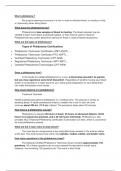Samenvatting
Summary phlebotomy_general_basics
What is phlebotomy ? The surgical opening or puncture of a vein in order to withdraw blood, to introduce a fluid, or (historically) when letting blood. What does the phlebotomist do? Phlebotomists take samples of blood for testing. The blood samples may be needed to learn more about a particular pa...
[Meer zien]




